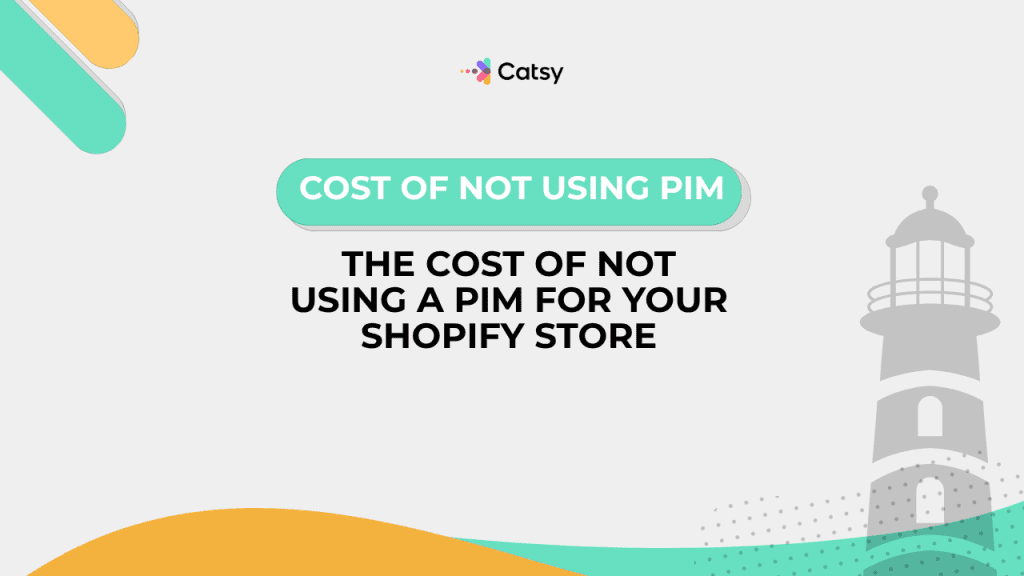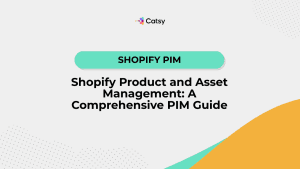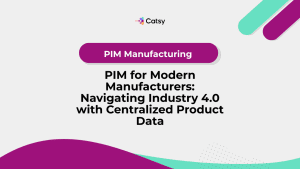The Cost of Not Using a PIM for Your Shopify Store
Without a data management system, Shopify merchants face hidden – and direct – costs. Learn about those costs and how to avoid them with Catsy’s PIM system.

Table of Contents
- Introduction: Sailing Blind Without a PIM
- What Happens Without a PIM?
- Hypothetical Scenario: A Tale of Two Shopify Stores
- How a Product Information Management Tool Eliminates These Costs
- Why Catsy is Built to Save Shopify Merchants from Catalog Chaos
- Conclusion: Don’t Sail Without a Map
What You Will Learn
- The hidden and direct costs Shopify merchants face without a PIM
- Real examples of how bad product data affects sales and brand
- How a catalog management system prevents inefficiencies and loss
- How Catsy’s PIM features resolve these pain points for Shopify sellers
- Key data points to justify PIM investment to stakeholders
In this Article
1. Introduction: Charting a Course Away from Manual Chaos
Imagine that you’re the captain of a ship, but your compass is cracked, your maps are outdated, and your crew is just working from memory. That’s what managing your product catalog without a product information management tool feels like.
When your data is scattered across spreadsheets, entered manually, and displayed inconsistently across your channels, you’re sailing into rough waters.
In this guide, we’re going to look at the real and measurable costs of not using a PIM for your Shopify store. The status quo is riskier (and more expensive) than you may think!
2. What Happens Without a PIM?
Without implementing a PIM, Shopify sellers often deal with:
- Conflicting product specs and descriptions across multiple sales channels
- Time-consuming manual edits to product pages
- Missed opportunities due to slow product launches
- Higher error rates and product returns
- Brand erosion due to inconsistent messaging
These issues inconvenience and frustrate your teams… but they also bleed revenue.
Let’s break down each cost.
Make Catsy DAM and PIM Software an Extension of Your Team
Book a Free Demo3. Cost #1: Lost Sales from Inaccurate or Incomplete Product Data
Poor product data acts like a broken sail. It slows you down and it throws you off course. Studies show that 30 percent of online shoppers abandon purchases due to missing or incorrect product information.
Put another way, if you’re a Shopify store doing $1 million in sales annually, that translates to $300,000 in lost sales … every single year.
Missing specs, vague descriptions, and unstructured content will confuse your shoppers. Without a PIM, these errors are nearly impossible to prevent as you scale.
4. Cost #2: Increased Returns Due to Mismatched Expectations
What happens when your customers receive products that don’t match the description? When the images you’ve linked don’t match the product variant? Returns, of course. And returns aren’t just sales that are lost. They carry reverse logistics costs, restocking fees, and customer churn.
According to Shopify, “high return rates are often caused by inaccurate product information or photos.”
So let’s say your store processes 10,000 orders a year, and a 5 percent return rate is caused by product misinformation. That’s 500 returns! At an average return cost of $10 to $15, that’s $5,000 to $7,500 annually, not counting the loss of your customers’ trust.
5. Cost #3: Higher Labor Costs from Manual Product Management
Are you managing product listings in multiple Shopify connections, markets, and other marketing channels? It’s exhausting, isn’t it? That’s especially true if you don’t employ automation.
Without a PIM:
- Your teams spend hours updating prices, specs, and images manually.
- Copywriters rewrite descriptions instead of using templates.
- Marketing teams constantly request data from product managers.
If your e-commerce team spends 20 hours each week on manual product updates, that’s over 1,000 hours paid annually. At an average $30 per hour wage, that’s $30,000 or more per year … wasted.
A modern catalog management system slashes that time with bulk editing, templates, and workflows.
6. Cost #4: Delays in Time-to-Market
Delays in launching new products or seasonal campaigns can translate into missed revenue windows. For example, launching a new product line two weeks late during Q4 could mean missing 20 percent of your total annual sales.
That’s a lot.
Without a PIM:
- Cross-functional approval workflows stall
- Assets are not connected to SKUs
- Localization is done manually and slowly
With a PIM, however, you can build workflows that automatically notify stakeholders of tasks, publish content simultaneously across channels, and launch products faster.
7. Cost #5: Damaged Brand Reputation from Inconsistent Messaging
Inconsistencies between your product pages, social ads, and packaging confuse customers and damage your brand.
Examples may include:
- Discrepancies in sizing or material specs
- Inconsistent product names across channels
- Mismatched imagery between social media platforms and your website
These misalignments don’t just hurt conversions, they undermine long-term trust in your brand.
With a PIM like Catsy, product content is managed from a single source of truth, ensuring consistent messaging from Shopify to Instagram to your email funnels.
8. Cost #6: Struggles with Scaling and Channel Expansion
Dreaming of expanding to Amazon, Walmart Marketplace, or even global markets? Without a PIM, you’ll hit a wall.
Each channel requires different information, including product templates, attribute fields, and country-specific localization.
Without automation, expansion becomes resource-heavy and unsustainable.
A PIM empowers you to:
- Syndicate data to multiple endpoints from one dashboard
- Customize feeds for each channel
- Easily handle Shopify Markets and international storefronts
9. Hypothetical Scenario: A Tale of Two Shopify Stores
Store A: Spreadsheet-Driven Chaos
- 5 percent higher return rate
- 20 percent slower product launches
- 30 percent higher content team overhead
- Customer complaints about conflicting info
Store B: Powered by PIM
- Unified product content pipeline
- 50 percent faster time-to-market
- Fewer customer complaints
- Ready for omnichannel expansion
The only difference is the PIM.
10. How a Product Information Management Tool Eliminates These Costs
Let’s look at how a PIM like Catsy solves each cost:
Cost | How PIM Solves It |
Lost Sales | Structured content, SEO optimization, media tagging |
Increased Returns | Accurate specs, visuals, variant control |
Labor Costs | Bulk editing, workflows, role permissions |
Time-to-Market | Automation, pre-built templates, readiness reports |
Brand Inconsistency | Single source of truth across all platforms |
Channel Expansion Friction | Syndication engines, channel-specific feed mapping |
Catsy’s automation, content governance, and Shopify-native features address each pain point directly, allowing you to keep your ship on course.
11. Why Catsy is Built to Save Shopify Merchants from Catalog Chaos
Catsy offers a Shopify-specific PIM solution that includes:
- Native Shopify integrations (including metafields, tags, and variants)
- Built-in DAM (digital asset management) for asset control
- Bulk editing tools and readiness reports
- Localization and multi-language support
- Automated workflows for product onboarding and approvals
- Channel syndication for Amazon, Walmart, and more
Whether you’re sailing with 100 or 100,000 SKUs, Catsy keeps your product data streamlined and ready to convert.
12. Conclusion: Don’t Sail Without a Map
Inaction comes at a cost, and that cost compounds over time.
Each manual update, every inconsistent spec, and every delayed launch – they all chip away at your profitability. Skipping the PIM may seem like a cost-effective solution, but selling without a PIM is like tossing your compass overboard.
Your Shopify store deserves better. With a product information management tool like Catsy, you set your course with precision and scale with confidence.
13. Key Takeaways
- Poor product data leads to lost sales, higher returns, and brand confusion
- Manual catalog management drains team resources and delays go-to-market
- Without a PIM, Shopify sellers struggle to scale across channels and markets
- Catsy offers Shopify-optimized features that eliminate chaos and boost revenue
- Investing in a catalog management system pays off through saved time, fewer errors, and stronger customer experiences
Want more tips, tutorials, and insights on product content and e-commerce operations?
Stay connected. We post regularly to help brands like yours scale smarter.
Are You Ready To streamline your product content management?

14. Frequently Asked Questions
The biggest risk of not using a PIM with Shopify is a loss of revenue. This is due to incorrect product data, higher return rates, and slower expansion into new markets.
Catalog management centralizes your product data, automates workflows, and ensures accurate and consistent content across all of your platforms and channels.
Yes! Catsy offers deep Shopify integration including metafields, tags, variants, and image publishing.
Absolutely not! Even mid-sized stores with growing SKU counts benefit significantly from automation, consistency, and faster time to market.
Many Catsy users report improved efficiency, faster product launches, and lower return rates within the first 3 to 6 months.
Subscribe For More Content
Sign up for monthly tips on how to drive revenue with product content.




